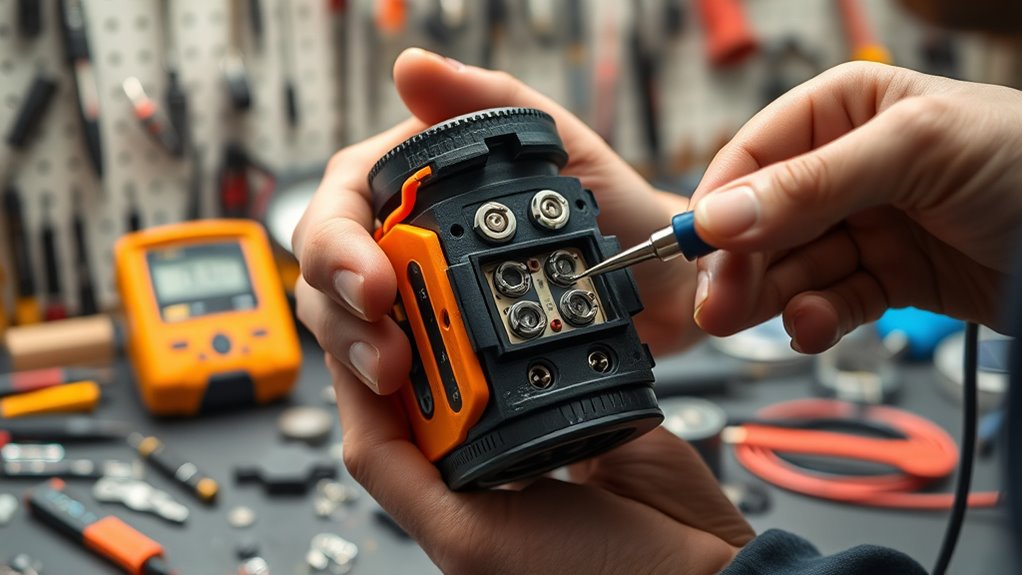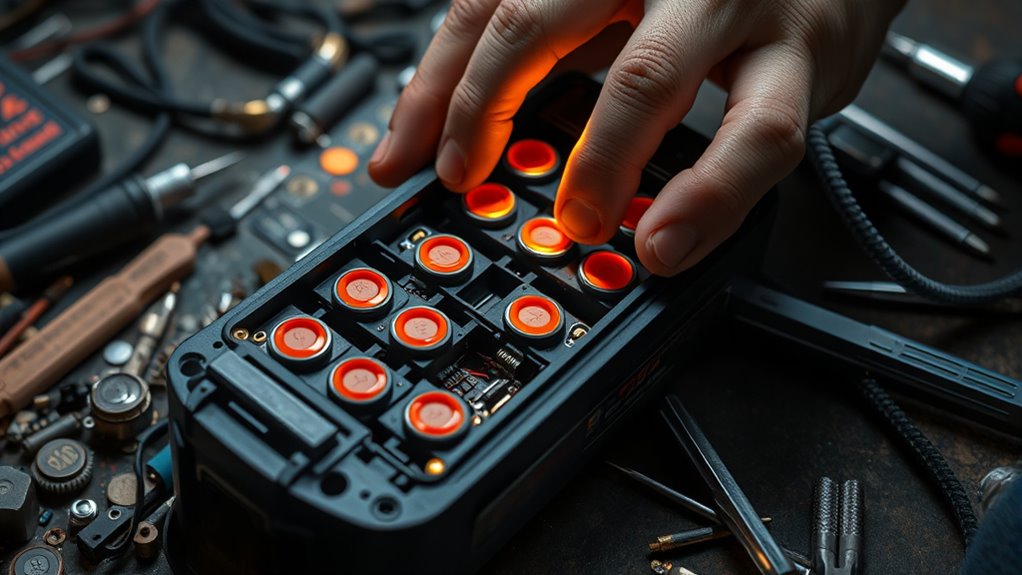To restore your power tool battery pack, start by inspecting it for damage and testing each cell’s voltage with a multimeter. Perform a full cycle charge—fully discharge then recharge—to recalibrate the pack. If needed, replace weak or faulty cells with matching ones for better balance. Follow proper charging routines and avoid leaving batteries in a full charge for long periods. Keep these steps in mind to boost performance and battery life—if you continue, you’ll learn more about each process.
Key Takeaways
- Inspect the battery pack for damage, corrosion, or loose connections before starting the restoration process.
- Fully discharge and recharge the battery to recalibrate its capacity and improve performance.
- Test individual cells with a multimeter; replace weak or low-voltage cells to restore balance.
- Perform cyclic conditioning with controlled charging and discharging to break down buildup and enhance longevity.
- Use the manufacturer-recommended charger and follow proper handling practices to prevent further degradation.

If your power tool battery isn’t holding a charge like it used to, don’t rush to replace the entire pack. Often, the issue lies within the battery’s chemistry or how it’s being charged. Understanding the underlying battery chemistry can help you diagnose and improve its performance. Most power tool batteries are lithium-ion or nickel-metal hydride, each with different charging requirements and behaviors. Lithium-ion batteries, for example, benefit from proper charging techniques that prevent overcharging and deep discharges, which can degrade their chemistry over time. By adjusting your charging habits, you can extend the life of your batteries and restore some of their original power.
Start by inspecting the battery pack for any visible damage, corrosion, or loose connections. If everything looks good, consider performing a full cycle charge—completely discharging the battery and then charging it to full capacity. This process can sometimes recalibrate the battery’s internal chemistry, helping it provide more accurate power readings. When charging, use the charger recommended by the manufacturer and avoid trickle charging or leaving the battery in a fully charged state for extended periods. Proper charging techniques are essential because they influence the health of the battery’s chemistry, preventing issues like capacity fade and voltage drops that cause poor runtime. Additionally, understanding battery technology advancements can guide you in selecting better batteries or accessories that support longer life.
Inspect for damage and perform full cycle charging to recalibrate and extend your battery’s life.
Next, if your battery pack has a removable cell configuration, you can test or replace individual cells. Use a multimeter to check each cell’s voltage; if some cells are markedly weaker or have a lower voltage, replacing those cells can restore balance and improve overall performance. When replacing cells, match their chemistry, capacity, and age to ensure consistent operation. If you’re unsure or uncomfortable doing this yourself, consulting a professional or following detailed guides can help you avoid damaging the pack further.
Another method to restore the battery involves conditioning it with controlled charging cycles. This means carefully charging and discharging the pack several times using a charger with adjustable current settings. This process can help break down buildup or memory effects within the battery, especially if it’s a nickel-based chemistry. However, be cautious—overdoing it can damage the battery, so always follow safe procedures and manufacturer guidelines.
Frequently Asked Questions
How Long Does a Typical Battery Restoration Process Take?
The restoration process usually takes about 4 to 8 hours, depending on your battery’s condition and charging time. You’ll need to fully charge the pack first, then allow it to rest before testing its capacity. The entire restoration duration involves multiple charging cycles, so patience is key. Keep in mind, some batteries might take longer if they’re severely degraded, but generally, expect a full process to be completed within a day.
Can All Types of Power Tool Batteries Be Restored?
You might be surprised, but not all power tool batteries can be restored. It depends on the battery chemistry and the extent of damage. Some Lithium-ion or NiMH batteries respond well to specific restoration methods, while others are too far gone. Always check the manufacturer’s guidelines and assess the battery’s condition first. Proper restoration can extend life, but knowing which types are salvageable saves you time and effort.
What Safety Precautions Should I Follow During Restoration?
You should always wear safety gear like gloves and eye protection before handling batteries. Follow proper handling procedures to prevent sparks or leaks, and work in a well-ventilated area. Disconnect the battery from power tools carefully, and keep a fire extinguisher nearby in case of emergencies. Never attempt to restore damaged or swollen batteries, and handle all components with caution to guarantee your safety throughout the process.
How Can I Tell if a Battery Is Beyond Repair?
When you’re trying to determine if a battery is beyond repair, don’t throw in the towel just yet. If it no longer holds a charge, shows significant damage, or has a drastically reduced battery lifespan, it’s likely time to replace. Repair costs might outweigh the value of restoring it. Usually, if it can’t be revived with simple fixes or reconditioning, it’s best to think about a new pack to save time and money.
Are There Professional Services for Battery Restoration?
Yes, there are professional repair services available for restoring your battery packs. You can find specialists who focus on battery recycling and professional repair, helping extend your batteries’ lifespan and guarantee safety. These experts assess the damage, replace cells if needed, and optimize performance. While some repairs are cost-effective, always consider whether recycling might be a better option if the battery is too far gone.
Conclusion
By restoring your battery packs, you breathe new life into your power tools, turning tired, sluggish batteries into spirited performers. Think of it as reviving a sleeping giant, awakening its full potential. With just a little effort, you transform a discarded, forgotten pack into a reliable partner for your projects. Keep your tools fueled and ready; with some care, your batteries will keep humming along, like a well-oiled machine—powering your creativity and craftsmanship for years to come.










